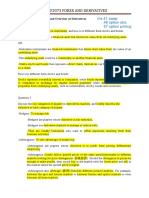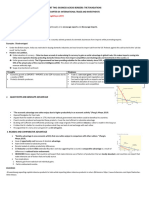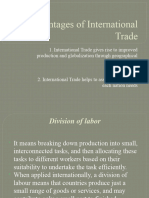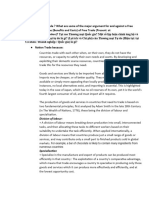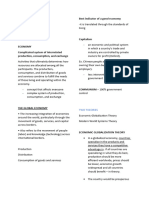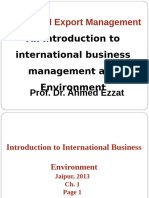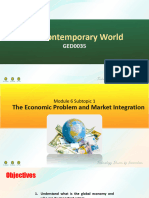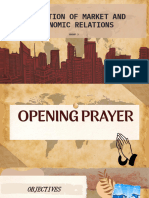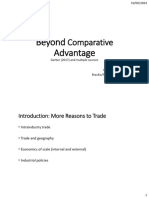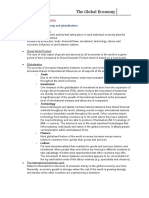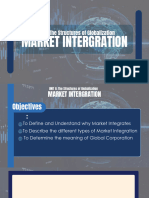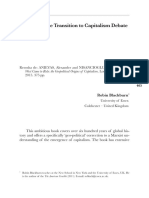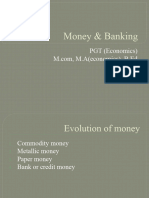Copy Contemp Reviewer
Copy Contemp Reviewer
Uploaded by
gerasmiodivineCopyright:
Available Formats
Copy Contemp Reviewer
Copy Contemp Reviewer
Uploaded by
gerasmiodivineCopyright
Available Formats
Share this document
Did you find this document useful?
Is this content inappropriate?
Copyright:
Available Formats
Copy Contemp Reviewer
Copy Contemp Reviewer
Uploaded by
gerasmiodivineCopyright:
Available Formats
The global economy is the result of the
GE 319 - The Contemporary development of an economy that rises above
borders and is free moving between the
World different nation states of the world.
But why do countries trade? Countries trade
with each other when, on their own, they do
Lesson 1: The Global Economy not have the resources, or capacity to satisfy
their own needs and wants.
• Globalization involves the
"broadening and deepening of The production of goods and services in
interdependence among peoples and countries that need to trade is based on
states”. two fundamental principles:
• It leads to an extension of geographic
linkages, encompassing societies and 1. Division of labor
states and deepens interaction - a division of labor means breaking
among them such that policies and down production into small,
events of one state also affect distant interconnected tasks, and then
ones. allocating these tasks to different
• Globalization is a multidimensional workers based on their suitability to
phenomenon comprised of political, undertake the task efficiently.
economic and cultural features. - a division of labor means that
countries produce just a small range
Szentes (2003) defines economic of goods or services and may
globalization as "a process making the contribute only a small part to finished
world economy an "organic system" by products sold in global markets.
extending transnational economic
processes and economic relations to more 2. Specialization
and more countries and by deepening the - is the second fundamental principle
economic interdependencies among them". associated with trade, and results
Benczes (2014) follows this definition and from the division of labor. Given that
emphasizes that interpretation of the current each worker, or each producer, is
trends in the world economy must be given a specialist role, they are likely
understood in the global context of an to become efficient contributors to the
integrated world economy. overall process of production, and to
the finished product.
Non-state actors such as international - can generate further benefits in terms
organizations, non-governmental of efficiency and productivity.
organizations, and multinational - can be applied to individuals, firms,
transnational or corporations play significant machinery and technology, and to
roles in the international economic whole countries.
processes. - International specialization is
In today’s borderless economy, the workings increased when countries use their
of the “invisible hand” have a reach and scarce resources to produce just a
strength beyond anything Adam Smith ever small range of products in high
could have imagined. volume.
- Mass production allows a surplus of
goods to be produced, which can then
be exported. This means that goods provides further cost benefits in
and resources must be imported from terms of economies of scale.
other countries that have also • Trade increases competition
specialized and produced surpluses and lowers world prices, which
of their own. provides benefits to consumers by
raising the purchasing power of
their own income and leads a rise
A. Principle of Absolute Advantage in consumer surplus.
(Adam Smith) • Trade also breaks down
- refers to the capability to produce domestic monopolies, which
more of a good or service than face competition from more
competitors using the same/abundant efficient foreign firms.
resources. • The quality of goods and
- We can say that a country has services is likely to increases as
absolute advantage in one commodity competition encourages
over another country if that country innovation, design and the
can produce the commodity more application of new technologies.
efficiently than the other country can. Trade will also encourage the
transfer of technology between
B. Principle of Comparative countries.
Advantage (David Ricardo) • Trade is also likely to increase
- refers to producing a good or service employment, given that
at a lower opportunity cost. employment is closely related to
- the basis, therefore, for specialization production. Trade means that
and trade, in general, is comparative more will be employed in the
advantage and not absolute export sector, and, through the
advantage. multiplier process, more jobs will
- countries specialize in and export be created across the whole
those goods and services where they economy.
have comparative advantage and
import those commodities where they
do not have comparative advantage. The disadvantages of trade:
• Trade can lead to over-
specialization, with workers at risk of
The advantages of trade: losing their jobs should world demand
• The exploitation of a country’s fall or when goods for domestic
comparative advantage, which consumption can be produced more
means that trade encourages a cheaply abroad. Jobs lost through
country to specialize in producing such changes cause severe structural
only those goods and services unemployment.
which it can produce more • Certain industries do not get a
effectively and efficiently, and at chance to grow because they face
the lowest opportunity cost. competition from more established
• Producing a narrow range of foreign firms, such as new infant
goods and services for the industries which may find it difficult to
domestic and export market establish themselves.
means that a country can produce • Local producers, who may supply a
in at higher volumes, which unique product tailored to meet the
needs of the domestic market, may underlying differences in factor
suffer because cheaper imports endowments but because in certain
may destroy their market. Over industries the world market can
time, the diversity of output in an support only a limited number of firms.
economy may diminish as local
Theory of National Competitive
producers leave the market.
Advantage
- Developed by Michael Porter,
The Pattern of International Trade attempts to explain why particular
nations achieve international success
The theories of Smith, Ricardo, and
in particular industries.
Heckscher–Ohlin help explain the pattern
- In addition to factor endowments,
of international trade that we observe in
Porter points out the importance of
the world economy:
country factors such as domestic
demand and domestic rivalry in
explaining a nation’s dominance in
Heckscher–Ohlin Theory
the production and export of products.
- emphasizes the interplay between the
proportions in which the factors of
production (such as land, labor, and Trade Theory and Government Policy
capital) are available in different
• International trade is generally seen
countries and the proportions in which
as beneficial, but theories differ on
they are needed for producing
government policy recommendations.
particular goods.
• Mercantilism advocates for
government intervention to promote
Product life-cycle Theory exports and limit imports (e.g.,
policies supported by Donald Trump).
- Proposed by Raymond Vernon, this
theory suggests that early in their life • Smith, Ricardo, and Heckscher-
cycle, most new products are Ohlin theories support unrestricted
produced in and exported from the free trade, arguing that import
country in which they were controls and export incentives are
developed. wasteful.
- As a new product becomes widely
• New Trade Theory and Porter's
accepted internationally, however,
National Competitive Advantage
production starts in other countries.
suggest limited government
As a result, the theory suggests, the
intervention to support certain
product may ultimately be exported
export-oriented industries.
back to the country of its original
innovation. Evidence for the Link between Trade and
Growth
• Numerous studies confirm a positive
New Trade Theory
link between trade openness and
- Developed by Paul Krugman, economic growth.
stresses that in some cases,
• Sachs and Warner found that open
countries specialize in the production
economies grew significantly faster
and export of products not because of
than closed economies from 1970 to
1990 (4.49% vs. 0.69% for developing Protectionism
countries; 2.29% vs. 0.74% for
- Supports restricting trade to protect
developed countries).
domestic industries and jobs, especially in
• Wacziarg and Welch found that trade strategic sectors like food or steel
liberalization from 1950–1998 production.
increased growth rates by 1.5–2.0%
- Protectionism may also be used to prevent
annually.
imports from countries with lower labor or
• Jeffrey Frankel and David Romer: A environmental standards from undercutting
1% increase in trade-to-GDP ratio local industries.
raises income per person by at least
Economists often agree that some
0.5%.
restrictions may be necessary but caution
• Free trade leads to long-term that excessive protectionism can lead to
economic growth and improved living higher prices and reduced overall wealth.
standards, despite short-term
adjustment costs.
Arguments for Free Trade
• Free trade increases the size of the
Trading with Many Commodities among
economy as a whole. It allows goods
Many Countries
and services to be produced more
• International trade involves many efficiently. That’s because it
countries and commodities, not just a encourages goods or services to be
two-country, two-commodity case. produced where natural resources,
• Countries rank commodities by infrastructure, or skills and expertise
comparative advantage and export are best suited to them. It increases
goods where they have the highest productivity, which can lead to higher
advantage. wages in the long term. There is
• Demand conditions in the widespread agreement that rising
international market influence which global trade in recent decades has
commodity is exported. increased economic growth.
• Most real-world trade is multilateral, • Free trade is good for consumers.
not just bilateral, but the principle of It reduces prices by eliminating tariffs
comparative advantage holds across and increasing competition. Greater
these scenarios. competition is also likely to improve
• Trade benefits all countries involved, quality and choice. Some things, such
but issues like displaced labor due to as tropical fruit, would not be
specialization require policy available in the UK without trade.
interventions, such as safety nets. • Reducing non-tariff barriers can
• remove red tape, thus reducing the
cost of trading. If companies that
Free Trade Vs Protectionism trade in several countries must work
Free trade with only one set of regulations, their
costs of ‘compliance’ come down. In
- Advocates for minimal restrictions on the principle, this will make goods and
movement of goods and services between services cheaper.
countries, aiming to maximize wealth • In contrast, protectionism can result in
through increased trade.
destructive trade wars that increase
costs and uncertainty as each side chlorine-washed chicken. There
attempts to protect its own economy. might also be pressure to reduce our
Protectionist rules can tend to favor standards for workers’ rights or
big business and vested interests, as environmental protection so that our
they have the resources to lobby most companies can compete with
effectively. companies in countries that have
lower standards.
Arguments for Protectionism
Lesson 2: Market Integration
• As more countries experience
industrial development, traditional
domestic industries can decline. In Economic systems vary from one society to
the UK, for example, the shipbuilding another. But in any given economy, production
industry has declined in the face of typically splits into three sectors.
international competition since the
Primary sector
1950s and currently steel production
faces increasing competition. - extracts raw materials from natural
Protectionism can help preserve jobs environments.
in these sectors, or at least slow the
Secondary sector
process of change.
• Protectionism can also help build - processes raw materials and
up new industries. In sectors with transforms them into manufactured
high start-up costs, new firms might goods.
find it difficult to compete if there is not
Tertiary sector
support from government in the form
of tariffs or subsidies. Once they have - involves providing services rather than
become competitive, such barriers producing goods.
can be removed. - this sector focuses on doing tasks
• Protectionism can be used to rather than making physical products.
safeguard ‘strategic’ industries
The Post-World War II Economic System
such as energy, water, steel,
and The Role of International Financial
armaments and food. For example,
Institutions in the Creation of a Global
‘food security’ may be seen as
Economy
important so that we can feed
ourselves if something terrible Bretton Woods Conference (July 1944):
happens to disrupt the system of
world trade. • Also known as the United Nations
• Some people worry that free trade Monetary and Financial Conference,
deals can lead to a lowering of held in Bretton Woods, New
standards. Such deals might require Hampshire, USA.
us to let in goods and services even • Delegates from 44 countries
though they don’t meet our standards, established a new international
which might then be cheaper than economic framework.
those made by domestic industries.
For example, some people have been
worried recently that a free trade deal
with the US might let in imports of
Creation of International Institutions: IMF Role in Preventing Trade Wars
Two key institutions were formed: • The IMF aimed to prevent trade wars
caused by competitive currency
• International Monetary Fund (IMF) devaluations, which were common
• World Bank (International Bank for during the interwar period.
Reconstruction and Development) • Countries with balance-of-payments
deficits often devalued their currencies
These are collectively known as the Bretton to boost exports and reduce imports.
Woods Institutions.
Balance-of-Payments Deficits
General Agreement on Tariffs and Trade
(GATT): • Occurs when a country spends more
than it earns.
• Created in 1947 after the Bretton • The IMF provides short-term loans to
Woods Conference. countries with temporary deficits to
• A more informal institution compared to prevent devaluation and maintain fixed
the IMF and World Bank but served as exchange rates.
the primary global trade organization.
• Designed to address the issues from Shift to Floating Exchange Rates
the interwar period, such as trade
protectionism and exchange • In 1971, the fixed-exchange-rate
controls. system collapsed, leading to the
• These issues were believed to have adoption of floating exchange rates.
contributed to the Great Depression • The IMF's role shifted to providing
and World War II. liquidity to countries linked to major
currencies.
Keystone International Economic
Organizations (KIEOs): Quota System
• The IMF is a quota-based institution,
• The Bretton Woods institutions played
a central role in global trade, where a state’s quota determines the
development, and monetary maximum number of financial
relations. resources it must provide.
• Quotas reflect a country’s relative
position in the global economy and
International Monetary Fund (IMF) determine voting power within the IMF.
• Established in 1945 to promote global Criticism and Western Dominance
monetary cooperation and international
• The IMF has been criticized for being
financial stability.
dominated by Western countries and
• Initially designed to monitor a system of
marginalizing the Global South and
pegged or fixed exchange rates where
emerging economies.
currencies were linked to gold and the
U.S. dollar.
• was designed to provide short-term
loans to aid countries facing balance-
of-payments deficits.
Global Financial Crisis and IMF Reform to less developed countries and the
reconstruction of war-torn countries in
The Global Financial Crisis (2007-2009) Europe.
prompted IMF reforms to improve its capacity
for crisis management. Two Institutions of the World Bank:
Two key elements of the reform: 1. IBRD (International Bank for
Reconstruction and Development):
1. IMF Resource Expansion: To Focuses on providing loans to middle-
enhance the institution’s financial crisis income and creditworthy low-income
management capabilities. countries.
2. Quota and Voting Power 2. IDA (International Development
Adjustments: Increase the quota and Association): Grants credits and loans
voting shares of emerging economies. to the lowest-income countries.
2010 Reform World Bank Group:
The World Bank is part of the larger World
• Involved doubling the IMF quota and Bank Group, which includes three other
shifting quota shares from over- institutions:
represented to under-represented
countries. 1. International Finance Corporation
• Increased representation of developing (IFC)
and emerging market economies. 2. Multilateral Investment Guarantee
• Redistributed seats in the Executive Agency (MIGA)
Board to restore legitimacy and improve 3. International Centre for Settlement
crisis management. of Investment Disputes (ICSID)
• More than 6% of the quota was shifted
to under-represented countries, Modern Role of the World Bank:
including emerging markets.
• Focuses on reducing extreme poverty
Trade-off in Reform Negotiations and addressing imperfections in global
capital markets.
• The reform resulted in a trade-off • Policy Influence: Rooted in its
between money and power, especially legitimacy and credibility, the World
involving the BRIC countries (Brazil, Bank impacts global economic policy,
Russia, India, China). particularly in donor and recipient
• The BRIC nations contributed more to countries.
IMF resources in exchange for greater • Its technocratic staff and multilateral
quota shares and representation on the status enhance its effectiveness
Executive Board.
• Despite reforms, the changes did not General Agreement on Tariffs and Trade
fully meet expectations for IMF (GATT)
restructuring and strengthening.
• Purpose: Avoid trade wars by raising
International Bank for Reconstruction and protectionist barriers, especially after
Development (World Bank) the interwar period.
• Created post-Bretton Woods, after the
• The World Bank grants long-term loans U.S. refused to sign the Havana
for economic development, especially
Charter, which aimed to establish the • The organization wields influence due
International Trade Organization (ITO). to the resources and economic power
• The U.S. agricultural sector feared the of its member countries, despite lacking
potential losses brought by the ITO, formal power.
leading to its failure.
• GATT was created as an informal, Organization of Petroleum Exporting
provisional treaty where participating Countries (OPEC)
states were "contracting parties"
rather than formal members. • OPEC was formed in 1960 by Saudi
• Focus: Liberalize trade but was limited Arabia, Iraq, Kuwait, Iran, and
in addressing the expansion of trade in Venezuela to increase the price of oil,
services, investment, and intellectual which had previously failed to keep up
property. with inflation.
• It also lacked a strong dispute • The current OPEC members also
settlement system. include the United Arab Emirates,
Algeria, Libya, Qatar, Nigeria, and
World Trade Organization (WTO) Indonesia.
• OPEC remains one of the major oil-
• Established in 1995 to replace GATT. exporting groups in the world today.
• More formal and capable of addressing
issues such as trade in services, European Union (EU)
investment, and intellectual property.
• Developed a stronger, more efficient • The EU consists of 28 member states.
system for dispute settlement. • Most members within the Eurozone use
• The global economic order shaped by the euro as their currency, but some,
the WTO was heavily influenced by like Great Britain, Sweden, and
Western developed countries. Denmark, have not adopted it.
• Critics argue that the euro increased
prices in Eurozone countries and
contributed to depressed economic
growth rates, particularly in Greece,
Spain, and Portugal.
• The European Central Bank's policies
are seen as playing a role in these
economic challenges.
NAFTA (North American Free Trade
Agreement)
• Formed on January 1, 1994, between
the United States, Mexico, and
Canada.
Organization for Economic Cooperation • Initially created in 1989 as a trade pact
and Development (OECD) between the United States and Canada
before Mexico joined.
• The OECD is an influential organization • Aims to develop and expand world
with 35 member states as of 2016, with trade by increasing international
Latvia being the most recent member. cooperation.
• Focuses on improving working Negative Consequences of NAFTA
conditions in North America and
reducing barriers to trade. • Excessive pollution due to increased
• Helps expand markets among the three industrial activities.
countries. • Loss of more than 682,000
manufacturing jobs in the U.S.
Effects of NAFTA on Mexico • Exploitation of workers in Mexico.
• Displacement of Mexican farmers from
• Manufacturing jobs moved from their businesses.
developed nations (U.S. and Canada)
to Mexico due to lower costs. International Monetary System:
• Producer prices in Mexico dropped,
A set of general rules, legal norms,
causing about 2 million farmers to leave
instruments, and institutions shaping payment
their farms.
conditions in foreign trade, brought by
• Consumer food prices increased,
multilateral international agreements
pushing 20 million Mexicans (25% of
facilitated by international financial
the population) into "food poverty."
organizations.
Impact of NAFTA on the United States
Gold Standard (Adopted by England, 1816):
• NAFTA contributed to U.S. GDP
• The first international monetary system,
growth, adding $127 billion annually
later joined by European countries and
through increased trade.
the U.S.
• Job losses and wage stagnation were
• A fixed exchange rate regime where
partly attributed to outsourcing to
countries determined the gold content
Mexico.
of their currencies, defining fixed
• About 791,000 U.S. jobs were
exchange rates.
outsourced to Mexico by 2010 due to
cheaper labor and fewer government
Features:
regulations.
• Unlimited convertibility of currencies
Impact of NAFTA on Canada
into gold.
• Stability in trade, eliminating exchange
• 76% of Canadian exports go to the
rate fluctuations.
United States.
• Automatic equilibrium of the trade
• A quarter of jobs in Canada are
balance.
dependent on trade with the United
• Non-inflationary since money issuance
States.
was dependent on a state's gold
• Changes or elimination of NAFTA could
reserves.
severely impact Canada's economy.
Weaknesses:
Positive Consequences of NAFTA
• Limited cash flow.
• Lowered prices by removing tariffs.
• Curbed economic development.
• Opened opportunities for small- and
• Dissolution marked by World War I due
medium-sized businesses.
to military spending demands.
• Quadrupled trade between the three
countries.
• Created 5 million U.S. jobs.
Gold Bullion Standard (Genoa, 1922): • Managed float systems permit central
bank interventions to address
• A modified gold standard involving the exchange rate fluctuations.
exchange of large sums of money for • Countries are prohibited from
gold bullion of fixed weight. manipulating their currencies for short-
• Failed to ensure free convertibility of term gains at the expense of others.
currencies into gold.
• Collapsed in 1931 with the outbreak of
the Great Depression (1929), which History of Market Integration: From a
triggered bankruptcies, a decrease in Unilateral to a Multilateral Trade Order
trade and production, and
unemployment. Mercantilist Period (17th-18th Centuries)
Bretton Woods System (1944): • Characterized by colonial expansion
and accumulation of gold reserves
• 44 countries agreed in creating a new through a favorable balance of
international system that would prevent payments.
the chaos that occurred during the • Aimed to boost exports and reduce
interwar period. imports in a zero-sum economic
• Known as the dollar-gold standard or framework.
gold-exchange standard: • Practiced beggar-thy-neighbor policies
• U.S. dollar as the only convertible leading to trade wars.
currency, backed by gold at US$35 per
ounce. 19th Century Industrialization and Trade
• Effective stability period: 1959 to 1968. Liberalization
1960s and 1970s: • The UK, as the first industrialized
country and global hegemon, promoted
• Introduced interventions like the Gold free trade, exemplified by the Repeal of
Pool and Special Drawing Rights to the Corn Laws in 1846.
expand resources and means of • The US and Germany initially rejected
payment. free trade, instead adopting import
• Despite these efforts, issues like U.S. substitution industrialization (ISI)
deficit, currency speculation, and policies to protect their infant industries
inflation led to the abandonment of the by imposing tariffs on manufactured
gold-exchange standard. goods.
• The Bretton Woods System collapsed
in 1973, leading to fluctuating exchange
rates determined by market forces.
Post-Bretton Woods Era:
World War I and Rise of Protectionism
• Countries moved to floating exchange
rates. • Free trade declined after the outbreak
• The IMF allows flexibility for member of WWI.
states to determine exchange rates or • The US, reluctant to assume British
peg them to major currencies like the hegemony, became a key driver of
U.S. dollar or SDR. protectionism, especially during the
Great Depression (1929-33).
• Retaliatory protectionist measures from • It introduced a binding and automatic
other countries exacerbated the decline dispute settlement mechanism, making
in global trade. it one of the most legalized international
institutions.
US Reciprocal Trade Agreements Act
(1932) Disillusionment of Developing States
• Aimed to address declining trade by • Developing countries were dissatisfied
transferring trade authority from with the Uruguay Round outcomes,
Congress to the US President, feeling they conceded more (especially
alleviating protectionist pressure. in services and intellectual property)
than they gained in agriculture and
Post-World War II Trade Regime textiles.
(Embedded Liberalism) • The Doha Round, labeled the
"development round," failed due to
• The post-WWII trade order was shaped opposing demands: developing
by Keynesian economics, promoting countries focused on agriculture, while
global trade with domestic safeguards. the US and EU were concerned with
• Trade negotiations were based on labor, environment, and investment.
principles like tariff reductions, non-
discrimination, reciprocity, safeguards, From Keynesianism to Neoliberalism
and development.
• However, the development principle Great Depression and Keynesianism:
often lacked prioritization by major
trading powers. • John Maynard Keynes: British
economist whose ideas shaped
Criticism of GATT economic policy during the Great
Depression (1930s).
• GATT faced challenges with • The General Theory of Employment,
inadequate dispute settlement Interest, and Money (1936): Keynes
mechanisms. argued that market-generated
• While tariffs were substantially equilibrium could lead to
reduced, non-tariff barriers (NTBs) like unemployment and lower demand,
environmental and health regulations which would reduce investment and
emerged, creating new challenges. production.
• Government intervention through fiscal
Creation of the WTO and monetary policies to boost
aggregate demand and revive the
• The creation of the WTO as "a economy.
legitimate multilateral institution, with • Keynes advocated for government
formal legal status as an international spending and "big government" to
organization and formal diplomatic support economic recovery.
status for its secretariat" was a • Keynesian Compromise: Promoted
development from the informal "club" of open markets with protections for
Western trading nations in GATT society and the domestic market,
• WTO formalized trade rules and including capital controls and trade
included goods, services, intellectual protections.
property, and investment.
Challenges to Keynesianism: 9. Deregulation
10. Property rights
• 1970s Stagflation: Economic crisis
characterized by rising unemployment These policies were implemented by
and inflation challenged the Keynesian international institutions like the IMF and
model. World Bank through Structural Adjustment
• Rise of Neoliberalism: Technological Programs (SAPs), often with conditionality
advancements and the free flow of clauses tied to loans.
capital and goods led to the resurgence
of liberalism. Criticism of Neoliberalism:
Neoliberalism: • SAPs were criticized for their adverse
effects on developing nations,
• Friedrich Hayek & Milton Friedman: exacerbating inequality between the
Advocated for minimal state global North and South.
intervention and an unregulated
market. Resistance to Neoliberalism:
• Neoliberal Policies:
o Privatization • Transnational and National
o Deregulation Movements: Global movements
o Reduced public spending emerged in response to neoliberal
o Lower corporate taxes globalization, challenging global
• Globalization: Neoliberalism promoted capitalism.
globalization and integration into the • Notable Movements:
global economy, with the belief that o Zapatista Movement (Mexico):
capitalism would bring prosperity and Opposed the North American
democratization. Free Trade Agreement
(NAFTA).
John Williamson (2004): Coined the term o Battle of Seattle (WTO
"Washington Consensus," a set of 10 Ministerial Conference,
economic policy prescriptions for developing 1990s): Protest neoliberal
and crisis-ridden nations: policies.
1. Fiscal discipline 21st Century Movements:
2. Reordering public expenditure
priorities • Spanish Indignados Movement
3. Tax reform • Arab Spring
4. Liberalizing interest rates • Occupy Movement
5. Competitive exchange rate
• These movements are part of the
6. Trade liberalization
7. Liberalization of inward foreign broader Global Justice Movement,
direct investment which fights against economic
8. Privatization inequality and the concentration of
wealth.
You might also like
- Futures Course - Contract Cheat SheetDocument13 pagesFutures Course - Contract Cheat Sheetnicolas.vandeloiseNo ratings yet
- Bbmf2073 Forex and Derivatives: Ms 41 Swap 46 Option Stra 57 Option PrisingDocument74 pagesBbmf2073 Forex and Derivatives: Ms 41 Swap 46 Option Stra 57 Option PrisingAIN NASUHANo ratings yet
- International Politics - Uli108u PDFDocument258 pagesInternational Politics - Uli108u PDFElizabeth ManhattanNo ratings yet
- Chapter 04.1Document15 pagesChapter 04.1ameziya adoraNo ratings yet
- The Contemporary World: - Week-3Document32 pagesThe Contemporary World: - Week-3John Michael TalaNo ratings yet
- Advantages of I B TDocument11 pagesAdvantages of I B T수지No ratings yet
- Session 4 VVDocument76 pagesSession 4 VVNachiket BanNo ratings yet
- GE3Document16 pagesGE3Aries C. GavinoNo ratings yet
- KTQT 3 37TDocument39 pagesKTQT 3 37TThùy Nguyễn NhưNo ratings yet
- The Global Economy ModuleDocument3 pagesThe Global Economy ModuleYram GambzNo ratings yet
- Chapter 7-8 ReviewerDocument4 pagesChapter 7-8 ReviewerUnknownNo ratings yet
- KTQT 2Document37 pagesKTQT 2thuyntp22No ratings yet
- Contemp World NotesDocument2 pagesContemp World Noteshed-fagustinNo ratings yet
- Ch1. Introduction To International Business and GlobalizationDocument37 pagesCh1. Introduction To International Business and Globalizationultramedic.regNo ratings yet
- Ibat ReviewerDocument7 pagesIbat ReviewerJulianne Hazel EpeNo ratings yet
- Eco Revision SheetDocument9 pagesEco Revision Sheetjonathan.al.rodd36No ratings yet
- International Business & TradeDocument8 pagesInternational Business & TradeCAMILLEJOY FRANCISCONo ratings yet
- Ibt M3Document4 pagesIbt M3AlisonNo ratings yet
- MGT1111 Chapters 1 3Document9 pagesMGT1111 Chapters 1 3Jhenica ParidoNo ratings yet
- Tmai DvuDocument29 pagesTmai Dvuk61.2213530045No ratings yet
- (M6-MAIN) The Global EconomyDocument34 pages(M6-MAIN) The Global Economymarkphet13No ratings yet
- International Business and TradeDocument9 pagesInternational Business and Trademinejasminejas.17No ratings yet
- IB Ngoài SáchDocument12 pagesIB Ngoài Sáchxuan thanhNo ratings yet
- CHAPTER 6 Scale Economies, Imperfect Competition, and TradeDocument4 pagesCHAPTER 6 Scale Economies, Imperfect Competition, and TradeAthena Fatmah M. AmpuanNo ratings yet
- International Financial Management PPT Chap 1Document25 pagesInternational Financial Management PPT Chap 1serge folegwe100% (1)
- MB0053 - International Business Management - 4 Credits: Master of Business Administration-MBA Semester 4Document54 pagesMB0053 - International Business Management - 4 Credits: Master of Business Administration-MBA Semester 4Vikash SharmaNo ratings yet
- Comparative Advantage and Gains From TradeDocument27 pagesComparative Advantage and Gains From TradeMikylla Rodriguez VequisoNo ratings yet
- International TradeDocument12 pagesInternational TradeshivaniguptaNo ratings yet
- Unit 4 - IBDocument8 pagesUnit 4 - IB03fl22bcl033No ratings yet
- BACC 4 – INTERNATIONAL TRADE (MIDTERMS REVIEWER)Document12 pagesBACC 4 – INTERNATIONAL TRADE (MIDTERMS REVIEWER)Ryza FloresNo ratings yet
- Globalization of Market and Economic RelationsDocument24 pagesGlobalization of Market and Economic RelationsMaria TheresaNo ratings yet
- Socsc 03 2Document50 pagesSocsc 03 2Rona mae MinaNo ratings yet
- Chapter 4Document29 pagesChapter 4NurulHuda Atikah Mohd ImranNo ratings yet
- Globalization: A Force To Economic GrowthDocument22 pagesGlobalization: A Force To Economic GrowthPeabeeNo ratings yet
- Ôn tập kinh tế quốc tế cuối kỳ 6Document36 pagesÔn tập kinh tế quốc tế cuối kỳ 6thuyntp22No ratings yet
- Resumen Global BusinessDocument13 pagesResumen Global Businesssofiaverna05No ratings yet
- 26 Business and The Inrternational EconomyDocument7 pages26 Business and The Inrternational EconomylandhooschoolstudentsNo ratings yet
- Weeks 1 - 2Document29 pagesWeeks 1 - 2davunaNo ratings yet
- Theories of International Trade PDFDocument16 pagesTheories of International Trade PDFDianneEsposo RomeroNo ratings yet
- Unit 1 - International Trade - Part 1 - To StsDocument13 pagesUnit 1 - International Trade - Part 1 - To Stsk61.2211510098No ratings yet
- Slides Aula - Comércio Intraindústria, Economias de Escala, e Política Industrial.Document12 pagesSlides Aula - Comércio Intraindústria, Economias de Escala, e Política Industrial.nadinypinheirocontatoNo ratings yet
- FIN542 Individu ReportDocument6 pagesFIN542 Individu ReportKÃLÅÏ SMÎLĒYNo ratings yet
- The Global EconomyDocument3 pagesThe Global Economym02k3No ratings yet
- BAC 104 - SG1 Introduction To International Business Trade 1Document4 pagesBAC 104 - SG1 Introduction To International Business Trade 1Bernadette MarchaNo ratings yet
- Chapter 03Document40 pagesChapter 03Alif AdiyatNo ratings yet
- Lecture 2:ITADocument4 pagesLecture 2:ITAChrisNo ratings yet
- Pre-Midterm Study Guide (MGCR-382) Lecture Notes For The First Half of The ClassDocument38 pagesPre-Midterm Study Guide (MGCR-382) Lecture Notes For The First Half of The ClassdarkninjaNo ratings yet
- Chapter 36Document17 pagesChapter 36ENG ZI QINGNo ratings yet
- International Trade Lecture 2 WeekDocument47 pagesInternational Trade Lecture 2 WeekSchwarzschild BlacksworthNo ratings yet
- Elec 4 Prelim ReviewerDocument5 pagesElec 4 Prelim Reviewerfujiko galboNo ratings yet
- Econdev FinalsDocument17 pagesEcondev FinalsJASMIN RHYZEL C. PINEDANo ratings yet
- Group3 MarketIntegrationDocument32 pagesGroup3 MarketIntegrationLaizabelsNo ratings yet
- Global Islamic Business Environment: Day One DATE: SAT, 10 JULY 2010 TIME: 9.00 AM - 5.00 PMDocument56 pagesGlobal Islamic Business Environment: Day One DATE: SAT, 10 JULY 2010 TIME: 9.00 AM - 5.00 PMNur IskandarNo ratings yet
- Business and International EconomyDocument4 pagesBusiness and International EconomySohan ShreyasNo ratings yet
- Intlbt Midterm Exam NotesDocument7 pagesIntlbt Midterm Exam NotesJohn Lorenz ToralNo ratings yet
- Human Geography - The Globalisation of Economic ActivityDocument49 pagesHuman Geography - The Globalisation of Economic ActivityYong Duan KangNo ratings yet
- Managerial Economis - Chapter 12Document5 pagesManagerial Economis - Chapter 12aeronjakesalesNo ratings yet
- Summarized Report of Group 1Document5 pagesSummarized Report of Group 1Caryl Relos BasterechiaNo ratings yet
- Structure of GlobalizationDocument6 pagesStructure of GlobalizationRachel Ann VelascoNo ratings yet
- Multinational Corporations (MNC'S) : Business OrganizationDocument42 pagesMultinational Corporations (MNC'S) : Business OrganizationAmit bailwalNo ratings yet
- Module 1.2 - Rise of GlobalizationDocument12 pagesModule 1.2 - Rise of GlobalizationGerald RamiloNo ratings yet
- Trade and Competitiveness Global PracticeFrom EverandTrade and Competitiveness Global PracticeRating: 5 out of 5 stars5/5 (1)
- Chapter 2 - SummaryDocument1 pageChapter 2 - SummaryLee's WorldNo ratings yet
- Gec103 Week3 The Global EconomyDocument17 pagesGec103 Week3 The Global EconomyAngel Joy CalisayNo ratings yet
- Shoppersstop Receipt 123463020627Document4 pagesShoppersstop Receipt 123463020627reach.njfilmsNo ratings yet
- Free Returns Are Complicated, Laborious, and Gross - The AtlanticDocument8 pagesFree Returns Are Complicated, Laborious, and Gross - The AtlanticindiolandNo ratings yet
- Hedging Example - Sheet1Document1 pageHedging Example - Sheet1Shaunny BravoNo ratings yet
- Activities of Foreign Exchange InternshiDocument50 pagesActivities of Foreign Exchange InternshiJannatul FerdousNo ratings yet
- 19Th Century Philippines: As Rizal'S ContextDocument17 pages19Th Century Philippines: As Rizal'S ContextMisor FireNo ratings yet
- Jawaban Kuis Uph Debt InvestmentDocument3 pagesJawaban Kuis Uph Debt InvestmentSagita Rajagukguk100% (1)
- The Gambia: From Entrepôt To Exporter and Eco-TourismDocument158 pagesThe Gambia: From Entrepôt To Exporter and Eco-TourismalexNo ratings yet
- Chapter 10 Marketing Channels To Create Value For CustomersDocument40 pagesChapter 10 Marketing Channels To Create Value For Customerssunchox123No ratings yet
- Bill SaharshaDocument1 pageBill SaharshaIver LothbrokNo ratings yet
- Kilobar Compendium: A Handbook For The International Gold MarketDocument23 pagesKilobar Compendium: A Handbook For The International Gold MarketThiti VanichNo ratings yet
- Blackburn Revisiting The Transition To Capitalism DebateDocument11 pagesBlackburn Revisiting The Transition To Capitalism DebatePseudoerasmus BucephalusNo ratings yet
- A Written Report About Facility LocationDocument6 pagesA Written Report About Facility LocationVelaNo ratings yet
- Intl Finance Assignment 2Document3 pagesIntl Finance Assignment 2Aalizae Anwar YazdaniNo ratings yet
- MGT201 Financial ManagementDocument13 pagesMGT201 Financial ManagementAsif AliNo ratings yet
- IGNOU Unit 19Document29 pagesIGNOU Unit 19Rupa BuswasNo ratings yet
- InvoiceDocument2 pagesInvoiceNiksNo ratings yet
- International Trade Regulation Lecture One SlidesDocument22 pagesInternational Trade Regulation Lecture One SlidesSandra ChowNo ratings yet
- CP Kurmi Tax Calc FY 2020-21-2Document12 pagesCP Kurmi Tax Calc FY 2020-21-2Yamraj DevtaNo ratings yet
- Money & BankingDocument33 pagesMoney & BankingGeeta GhaiNo ratings yet
- NCR NegoSale Batch 15160 050823-WinBuyDocument5 pagesNCR NegoSale Batch 15160 050823-WinBuyCharlie TacanNo ratings yet
- Kautilya'S " Arthashastra" and Modern EconomicsDocument6 pagesKautilya'S " Arthashastra" and Modern Economicsamiya anandNo ratings yet
- International Business, 8th Edition: Griffin & PustayDocument36 pagesInternational Business, 8th Edition: Griffin & PustayAdi NataNo ratings yet
- Oil Prices DecreasedDocument2 pagesOil Prices DecreasedYuvan MoroganNo ratings yet
- Chapter 6 ECON NOTESDocument10 pagesChapter 6 ECON NOTESMarkNo ratings yet
- Bajaj Finance Sip ReportDocument57 pagesBajaj Finance Sip ReportSwaraj DasNo ratings yet

